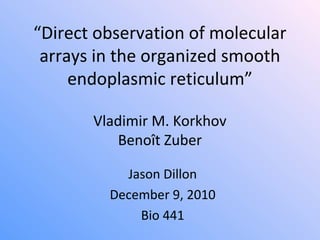
Direct observation of molecular arrays stabilizing organized smooth endoplasmic reticulum sheets
- 1. “Direct observation of molecular arrays in the organized smooth endoplasmic reticulum” Vladimir M. Korkhov Benoît Zuber Jason Dillon December 9, 2010 Bio 441
- 2. Background and Terms • ER – Rough – Smooth • Evolutionary conservation – Yeast to mammals – 50-100 nm luminal intermembrane distance • Tubes vs. Sheets – Cell cycles Matthew Damstrom Organelles Project. Web. <http://liquidbio.pbworks.com/w/page/11135266/ Matthew-Damstrom-Organelles-Project>.
- 3. Organized Smooth ER (OSER) • Cubic • Tubular • Stacked sheets • Membrane & organelle biogenesis • Comprises part of nuclear envelope • Peripheral ER – microtubules and membrane sheets
- 4. Possible Stabilizers • Reticulons and DP1 (tubule stabilization) –Induce high membrane curvature • Nuclear envelope –Flat double sheet –SUN prot. •Span NE lumen (nucleus to cytoskeleton via Nesprin)
- 5. More Possibilities • Weak interactions, fluorescent prot. tags –On ER-resident prot.’s (cytoch.-b5, Sec61) –May stabilize ER sheets –May induce OSER formation • Peripheral ER sheets –Climp63 • Microtubule-binding protein (binds to cytoskeleton)
- 6. Calnexin • Assists protein conformation/folding • Lectin chaperone with a single transmembrane-spanning domain • Overexpression –Induces stacked OSER membranes •Very dynamic
- 7. OSER Membrane Expansion • Emery-Dreiffuss disease • Torsion dystonia • Hodgkin’s lymphona • Response to stress –Excessive malformed proteins
- 8. Intent of Experiment • Identify mol.’s inducing organization of smooth ER sheets • OSER membrane stracks highly regular • Ordered tethering of membranes –Large native complex (unknown) –Not through heterologously overexpressed proteins
- 9. Materials • DMEM and standard cell-culture reagents • SUN1 and SUN2 antibodies • Nesprin-1 antibody • Anti-rabbit antibody conjugated with Texas Red • Climp63-GFP construct • Calnexin constructs
- 10. Methods • HEK293 cells –Cultured at 37°C –Supplemented with 5% CO2 • Transfections – Lipofectamine-2000 –24 μg of plasmid DNA • Individual transfection reaction per 3 cm plate –10 μg of plasmid DNA • Transfect cells growing in 10 cm dishes
- 11. Confocal Microscopy • Poly-l-glutamate-coated glass cover-slips –Grown until 5080% confluence • Transfection/fixation –Cells fixed w/ 4% paraformaldehye • PO4-buffered saline (PBS) –Permeabilized 30 min.’s @ room temp. • PBS w/ 1% BSA & 0.01% Triton-X100 –Stained 1 hr. with 1o & 2o antibodies
- 12. Confocal Microscopy contd. • Stained coverslips washed 4x in PBS –Mounted on glass slides in Vectashield medium • Images acquired by Zeiss LSM 510 confocal microscope –63x obj. lens
- 13. Cryo-electron Microscopy of Vitreous Sections (CEMOVIS) • Cells centrifuged 5 min.’s @ 1400 rpm – Resuspended in 30% dextran-PBS • Cells introduced into 200μm deep cavity of copper membrane carrier – Vitrified by high pressure freezing • Membrane carriers clamped into specimen holder – Trimmed in pyramidal shape w/ diamond knife
- 14. CEMOVIS • Cryosections collected on 1000-mesh grids –Coated w/C –Stored in liquid N • Tecnai T12 microscope –Film –2,600,030,000x
- 15. Intermembrane Distances • Images scanned and digitized • OSER membranes stacked parallel & perp. • Intermembrane distances measured –~30% compression due to cutting –Fourier transformation/filtered image calculation • Cutting by diamond knife did not affect selected regions
- 16. Results • GFP-tagged memb. proteins (hypothesized) – Weakly interact w/ each other – may lead to stacking • Intrinsic extramembranous domains of ER proteins • Self-association • Fluorescent prot. dimerization not a pre-requisite – Calnexin-mCherry fusion as potent as YFP-/CFP-calnexin
- 17. Co-expression of Calnexin- and Climp63-GFP (HEK293) • Climp63 – Contains extended luminal coiled-coil domain – Large, rod-shaped aggregates – Possible stacking of OSER membranes • No colocalization • Climp63-GFP – Not found in calnexin-GFP positive multilamellar bodies – Doesn’t stabilize OSER stacks
- 18. LINC Complex & Nesprin 1 • Nuclear Envelope proteins – SUN1 & SUN2 connect inner NE with outer – Cells over-expressing calnexin – Endogenous SUN proteins excluded from calnexin-induced OSER memb.’s • Endogenous Nesprin-1 – NE to actin cytoskeleton – Spectrin repeats --> possible oligomerization – Excluded from calnexin-CFP stained OSER memb.
- 19. Figure 1 – Confocal Microscopy •OSER membrane biogenesis sustained by monomeric fluorescent protein fusion expression •Does not involve Climp63, SUN, or Nesprin1 proteins
- 20. CEMOVIS Analysis of HEK293 Cells • Over-expressing calnexin-YFP • 55 vitreous section micrographs • Intermembrane spacing uniformity –Cytosolic & luminal compartments –25.3 nm b/t cytosolic, 36.5 nm (perpendicular) –38.6 nm b/t luminal, 49.8 nm (perpendicular)
- 21. Stabilization • Over-expressed proteins (i.e. calnexin) not enough • Luminal domain length of calnexin too short
- 22. Figure 2 - Luminal and Cytosolic Distances Black arrowheads demonstrate cytosolic space Open arrow = cutting direction
- 23. CEMOVIS Micrographs • Proteins packed tighter in OSER than peripheral ER • Closely spaced arrays of globular complexes at cytosolic face –On outermost membrane –Trapped inside –Complexes still unknown (less than ½ size of ribosome)
- 24. Figure 3 – Molecular Arrays at OSER membranes
- 25. F. Dynamic, high flexibility 20nm G. Plot of angle vs. intermembrane distance
- 26. Conclusions • CEMOVIS imaging technique preserved in vivo-like conditions (hydrated) • Ordered cytosolic and luminal macromolecular arrays (complexes) – OSER stacking • Fluorescent protein dimerization does not lead to induction of OSER sheets • ER-localized proteins may act in stabilization – Cytochrome B5, HMG-CoA reductase
- 27. New Proposed Model • OSER membranes are stabilized by extended arrays of “adhesion” molecules – Less ordered than desmosome junctions • Identity remains unknown • Still unknown whether “adhesion” molecules induce OSER stack formation, or stabilize after formation